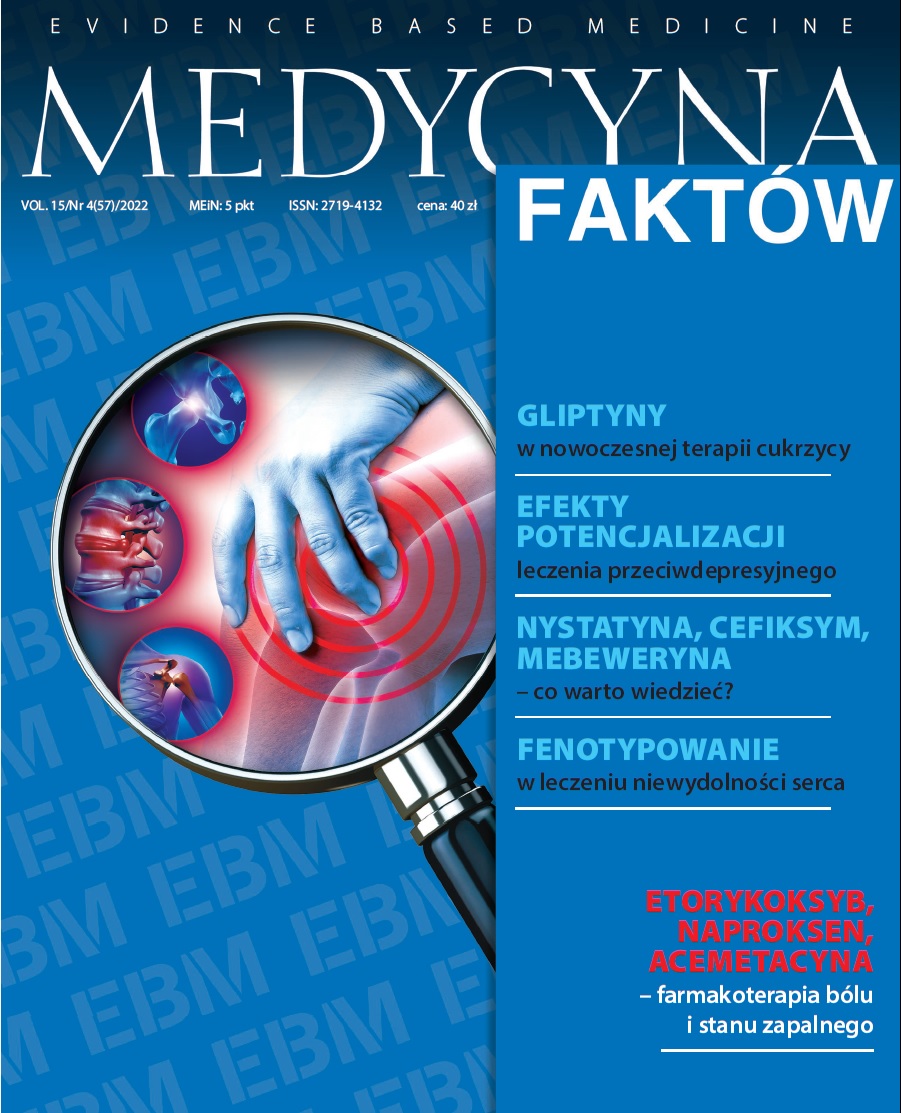Vertigo in seniors – a case report Case report
Main Article Content
Abstract
In the elderly vertigo is a more serious problem than in other age groups because of the increased risk of falls and secondary fractures, especially of the femoral neck. Vertigo has wide etiology (from damage to the vestibular system, through cardiovascular and metabolic disorders, intoxication, damage to both the peripheral and central nervous system to psychogenic ailments), so in the treatment of the elderly it is necessary to identify patients with serious illnesses requiring urgent diagnosis and treatment in a hospital. The paper presents a diagnostic and treatment of a senior with benign paroxysmal positional vertigo.
Article Details
How to Cite
Onopiuk, P., & Pionka, M. (2022). Vertigo in seniors – a case report. Medycyna Faktow (J EBM), 15(4(57), 462-466. https://doi.org/10.24292/01.MF.0422.15
Issue
Section
Articles
Copyright © by Medical Education. All rights reserved.
References
1. Colledge NR, Wilson JA, Macintyre CC, MacLennan WJ. The prevalence and characteristics of dizziness in an elderly community. Age Ageing. 1994; 23(2): 117-20.
2. Hilton MP, Pindr DK. The Epley (canalith repositioning) manoeuvre for benign paroxysmal positional vertigo. Cochrane Database Syst Rev. 2014(12): CD003162. http://doi.org/10.1002/14651858.CD003162.pub3.
3. Newman-Toker DE, Hsieh YH, Camargo CA Jr et al. Spectrum of dizziness visits to US emergency departments: cross-sectional analysis from a nationally representative sample. Mayo Clin Proc. 2008; 83(7): 765-75. http://doi.org/10.4065/83.7.765.
4. Neuhauser HK. Epidemiology of vertigo. Curr Opin Neurol. 2007; 20: 40-6.
5. Bhattacharyya N, Gubbels SP, Schwartz SR et al. Clinical Practice Guideline: Benign Paroxysmal Positional Vertigo (update). Otol. Head Neck Surg. 2017; 156(3): 1-47.
6. von Brevern M et al. Epidemiology of benign paroxysmal positional vertigo: a population based study Journal of Neurology. Neurosurgery & Psychiatry. 2007; 78: 710-5.
7. Oghalai JS, Manolidis S, Barth JL et al. Unrecognized benign paroxysmal positional vertigo in elderly patients. Otolaryngol Head Neck Surg. 2000; 122: 630-4.
8. Seok JI, Lee HM, Yoo JH et al. Residual dizziness after successful repositioning treatment in patients with benign paroxysmal positional vertigo. J Clin Neurol. 2008; 4: 107-10. http://doi.org/10.3988/jcn.2008.4.3.107.
9. Gbahou F. Effects of betahistine at histamine H3 receptors: mixed inverse agonism/agonism in vitro and partial inverse agonism in vivo. J Pharmacol ExpTher. 2010; 334: 945-54.
10. Ramos Alcocer R. Use of betahistine in the treatment of peripheral vertigo. Acta Otolaryngol. 2015; 135(12): 1205--11. http://doi.org/10.3109/00016489.2015.1072873.
11. Guneri EA. The effects of betahistine in addition to Epley maneuver in posterior canal benign paroxysmal positional vertigo. Otolaryngol Head Neck Surg. 2012; 146: 104-8.
12. Benecke H Pérez-Garrigues H, Bin Sidek D et al.; OSVaLD investigators. Effects of betahistine on patient-reported outcomes in routine practice in patients with vestibular vertigo and appraisal of tolerability: experience in the OSVaLD study. Int Tinnitus J. 2010; 16(1): 14-24.
13. Swain S, Behera ICh, Das A et al. Prevalence of Benign Paroxysmal Positional Vertigo: Our experiences at a tertiary care hospital of India. http://doi.org/10.21608/ejentas.2018.5246.1040.
14. Błażejewska-Hyżorek B. Ostry zespół przedsionkowy – czy to udar? Badanie przy łóżku chorego kluczem do rozpoznania. Otorynolaryngologia. 2014; 13(1): 12-6.
15. Wiącek M, Sadza I, Bartosik-Psujek H. Diagnostyka zawrotów głowy w warunkach szpitalnego oddziału ratunkowego. Pol Przegl Neurol. 2018; 14(4): 209-21.
2. Hilton MP, Pindr DK. The Epley (canalith repositioning) manoeuvre for benign paroxysmal positional vertigo. Cochrane Database Syst Rev. 2014(12): CD003162. http://doi.org/10.1002/14651858.CD003162.pub3.
3. Newman-Toker DE, Hsieh YH, Camargo CA Jr et al. Spectrum of dizziness visits to US emergency departments: cross-sectional analysis from a nationally representative sample. Mayo Clin Proc. 2008; 83(7): 765-75. http://doi.org/10.4065/83.7.765.
4. Neuhauser HK. Epidemiology of vertigo. Curr Opin Neurol. 2007; 20: 40-6.
5. Bhattacharyya N, Gubbels SP, Schwartz SR et al. Clinical Practice Guideline: Benign Paroxysmal Positional Vertigo (update). Otol. Head Neck Surg. 2017; 156(3): 1-47.
6. von Brevern M et al. Epidemiology of benign paroxysmal positional vertigo: a population based study Journal of Neurology. Neurosurgery & Psychiatry. 2007; 78: 710-5.
7. Oghalai JS, Manolidis S, Barth JL et al. Unrecognized benign paroxysmal positional vertigo in elderly patients. Otolaryngol Head Neck Surg. 2000; 122: 630-4.
8. Seok JI, Lee HM, Yoo JH et al. Residual dizziness after successful repositioning treatment in patients with benign paroxysmal positional vertigo. J Clin Neurol. 2008; 4: 107-10. http://doi.org/10.3988/jcn.2008.4.3.107.
9. Gbahou F. Effects of betahistine at histamine H3 receptors: mixed inverse agonism/agonism in vitro and partial inverse agonism in vivo. J Pharmacol ExpTher. 2010; 334: 945-54.
10. Ramos Alcocer R. Use of betahistine in the treatment of peripheral vertigo. Acta Otolaryngol. 2015; 135(12): 1205--11. http://doi.org/10.3109/00016489.2015.1072873.
11. Guneri EA. The effects of betahistine in addition to Epley maneuver in posterior canal benign paroxysmal positional vertigo. Otolaryngol Head Neck Surg. 2012; 146: 104-8.
12. Benecke H Pérez-Garrigues H, Bin Sidek D et al.; OSVaLD investigators. Effects of betahistine on patient-reported outcomes in routine practice in patients with vestibular vertigo and appraisal of tolerability: experience in the OSVaLD study. Int Tinnitus J. 2010; 16(1): 14-24.
13. Swain S, Behera ICh, Das A et al. Prevalence of Benign Paroxysmal Positional Vertigo: Our experiences at a tertiary care hospital of India. http://doi.org/10.21608/ejentas.2018.5246.1040.
14. Błażejewska-Hyżorek B. Ostry zespół przedsionkowy – czy to udar? Badanie przy łóżku chorego kluczem do rozpoznania. Otorynolaryngologia. 2014; 13(1): 12-6.
15. Wiącek M, Sadza I, Bartosik-Psujek H. Diagnostyka zawrotów głowy w warunkach szpitalnego oddziału ratunkowego. Pol Przegl Neurol. 2018; 14(4): 209-21.

